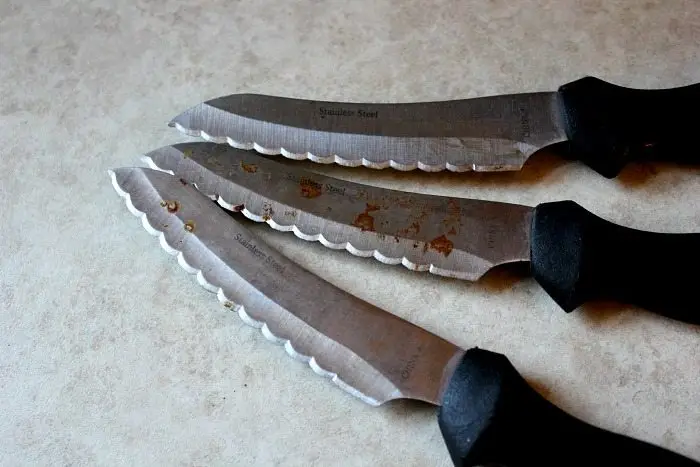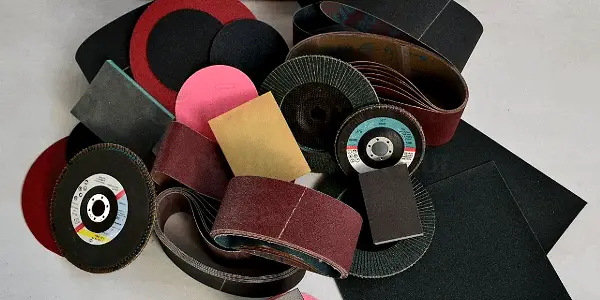Rust spots on knives can be frustrating and unsightly, especially if you have invested in a high-quality blade. Not only do they detract from the appearance of your knife, but they can also weaken the metal, causing your blade to become less effective over time. In this blog post, we will explore the causes of rust spots on knives and discuss several methods for preventing and removing them.
We will start by examining the different factors that can contribute to the formation of rust spots, including exposure to moisture, high humidity levels, and the presence of salt or acidic substances. Then, we will look at the most effective ways to prevent rust, including proper storage and maintenance, and the use of protective coatings. Finally, we will explore different methods for removing rust from your knife, including the use of abrasive materials, chemical treatments, and natural remedies.
So, if you want to keep your knives in top condition, make sure to read on! Whether you’re a seasoned chef or a home cook, this post will provide valuable information on how to care for your knives and prevent rust from ruining their appearance and performance.
Rust Spots On Knives
First off, rust spots are just the worst. They can make your once shiny and beautiful knife look dull and worn out. But don’t worry, there are plenty of ways to remove rust and keep your knives looking their best.
Some different methods for removing rust are more effective than others. One of the best methods is using abrasive materials, like sandpaper or a wire brush. They can be a bit time-consuming, but they do the job well and can get rid of stubborn rust spots. I also like using chemical treatments, like vinegar or lemon juice, which can dissolve the rust and make it easier to wipe away. Just be sure to rinse the knife thoroughly after using any chemical treatment to avoid damaging the blade.
Another great way to prevent rust is to keep your knives dry and store them properly. Investing in a knife block or a magnetic knife holder can keep your knives safe and dry, and protect them from moisture that can cause rust to form. And of course, you can also use a protective coating, like oil or wax, to keep moisture away from your knife’s surface.
All in all, there are plenty of great products and methods out there to help you remove rust from your knives and keep them looking like new. So go ahead, try out some of these tips and enjoy your rust-free, shining knives!
Guide on Methods of Solving Rust Spots on Knives and Make a Comparison Table
Method 1: Abrasive Materials
One common solution for removing rust spots from knives is the use of abrasive materials, such as sandpaper or a wire brush. This method involves gently scrubbing the affected area with the abrasive material until the rust is removed. Abrasive materials can be very effective in removing rust, but they can also be time-consuming and potentially damaging to the knife’s surface.
Pros:
- Can effectively remove rust
- Does not require any special chemicals or tools
Cons:
- Can be time-consuming
- Can scratch or damage the knife’s surface if not used carefully
Method 2: Chemical Treatments
Another solution for removing rust is the use of chemical treatments, such as vinegar or lemon juice. This method involves soaking the affected area in the chemical solution for a period of time, allowing it to dissolve the rust. Chemical treatments can be a convenient solution, but they can also be harsh and potentially damaging to the knife’s surface.
Pros:
- Convenient and easy to use
- Can effectively dissolve rust
Cons:
- Can be harsh on the knife’s surface
- Requires careful rinsing to avoid damaging the blade
Method 3: Natural Remedies
Natural remedies, such as baking soda or salt, can also be used to remove rust spots from knives. This method involves mixing the natural remedy with a small amount of water to form a paste, and then applying the paste to the affected area and allowing it to sit for a period of time. Natural remedies can be a gentle solution, but they may not be as effective as other methods.
Pros:
- Gentle and safe for the knife’s surface
- Does not require any special chemicals or tools
Cons:
- May not be as effective as other methods
- Can be time-consuming
In Comparison
| Method | Pros | Cons |
|---|---|---|
| Abrasive Materials | Can effectively remove rust | Can be time-consuming, can scratch or damage the knife’s surface |
| Chemical Treatments | Convenient and easy to use, can effectively dissolve rust | Can be harsh on the knife’s surface, requires careful rinsing |
| Natural Remedies | Gentle and safe for the knife’s surface, does not require any special chemicals or tools | May not be as effective as other methods, can be time-consuming |
In Conclusion
There are several methods for removing rust spots from knives, each with its own pros and cons. Whether you choose to use abrasive materials, chemical treatments, or natural remedies, the important thing is to take action to prevent rust from affecting the appearance and performance of your blades. By following the information provided in this guide and choosing the method that works best for you, you can keep your knives looking and performing like new.

Table of Equipment for Solving Rust Spots on Knives
| Equipment | Description | Purpose |
|---|---|---|
| Sandpaper or Wire Brush | Abrasive materials used for removing rust | Scrubbing the affected area to remove rust |
| Vinegar or Lemon Juice | Chemical substances used to dissolve rust | Soaking the affected area to dissolve rust |
| Baking Soda or Salt | Natural substances used to remove rust | Mixing with water to form a paste and applying to the affected area to remove rust |
| Protective Gloves | Protective gear for hands | Protecting hands from harsh chemicals or abrasive materials |
| Rag or Sponge | Soft cloth or sponge for cleaning | Wiping away any residue or cleaning the knife after using a rust removing method |
| Knife Sharpener | A tool for sharpening knives | Restoring the sharpness of the knife after removing rust spots |
Note: The equipment listed above are just suggestions and may vary depending on the method used to remove rust spots from knives.

Step-by-Step Guide for Removing Rust Spots on Knives
- Gather all necessary equipment: Before starting, gather all the necessary equipment listed in the table above, such as sandpaper or wire brush, vinegar or lemon juice, baking soda or salt, protective gloves, a rag or sponge, and a knife sharpener.
- Protect your hands: Put on your protective gloves to protect your hands from harsh chemicals or abrasive materials.
- Clean the knife: Use a damp rag or sponge to clean the knife and remove any dirt or debris from the affected area.
- Determine the best method: Based on the type and severity of the rust spots, determine the best method to remove them. For small or light rust spots, vinegar or lemon juice may be enough. For heavier rust spots, sandpaper or wire brush may be necessary.
- Soak the knife in vinegar or lemon juice: If using vinegar or lemon juice, fill a container with enough to fully submerge the affected area. Soak the knife for 30 minutes to an hour, then use a wire brush or sandpaper to remove the rust. Repeat the process if necessary.
- Make a paste with baking soda or salt: If using baking soda or salt, mix a small amount with water to form a paste. Apply the paste to the affected area and let it sit for 15-20 minutes. Then, use a wire brush or sandpaper to remove the rust. Repeat the process if necessary.
- Clean the knife: After removing the rust, use a damp rag or sponge to clean the knife and remove any residue.
- Sharpen the knife: Finally, use a knife sharpener to restore the sharpness of the knife if necessary.
- Store the knife properly: Store the knife in a dry place to prevent future rust spots.
Note: Remember to use caution and follow all safety precautions when removing rust spots from knives, especially when using harsh chemicals or abrasive materials.
FAQ
How can I prevent rust spots on my knives?
You can prevent rust spots on your knives by storing them in a dry place, keeping them clean and dry, and avoiding prolonged exposure to moisture. Additionally, using a knife oil or rust inhibitor can help protect the blades from rusting.
Can vinegar or lemon juice remove heavy rust spots on knives?
Vinegar or lemon juice can help dissolve light or small rust spots, but for heavy or severe rust spots, it may not be enough. In these cases, sandpaper or a wire brush may be necessary to physically remove the rust.
Is it safe to use baking soda or salt to remove rust spots on knives?
Yes, baking soda or salt are safe and natural substances that can be used to remove rust spots on knives. However, it is important to follow the instructions carefully and not overuse, as excessive use of abrasive materials can cause damage to the blade.
Can rust spots on knives be repaired?
Yes, rust spots on knives can be removed using various methods, such as vinegar or lemon juice, baking soda or salt, sandpaper, or wire brush. However, if the rust has caused significant damage to the blade, it may not be repairable and a replacement may be necessary.
How can I keep my knives rust-free after removing the rust spots?
After removing the rust spots, store the knife in a dry place and keep it clean and dry. Additionally, using a knife oil or rust inhibitor can help protect the blades from rusting in the future.



Leave a Reply